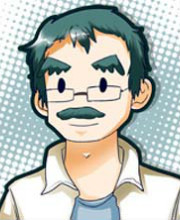| 图片: | |
|---|---|
| 名称: | |
| 描述: | |
- Earliest Steps to Find Breast Cancer Are Prone to Error , New York Time
http://video.nytimes.com/video/2010/07/19/health/1247468417562/pathology-of-errors.html
Earliest Steps to Find Breast Cancer Are Prone to Error
By
STEPHANIE SAULMonica Long had expected a routine appointment. But here she was sitting in her new oncologist’s office, and he was delivering deeply disturbing news.
Nearly a year earlier, in 2007, a pathologist at a small hospital in Cheboygan, Mich., had found the earliest stage of
breast cancer from a biopsy. Extensive surgery followed, leaving Ms. Long’s right breast missing a golf-ball-size chunk.Now she was being told the pathologist had made a mistake. Her new doctor was certain she never had the disease, called ductal carcinoma in situ, or D.C.I.S. It had all been unnecessary — the surgery, the radiation, the drugs and, worst of all, the fear.
"Psychologically, it’s horrible," Ms. Long said. "I never should have had to go through what I did."
Like most women, Ms. Long had regarded the breast biopsy as the gold standard, an infallible way to identify
cancer. "I thought it was pretty cut and dried," said Ms. Long, who is a registered nurse.As it turns out, diagnosing the earliest stage of breast cancer can be surprisingly difficult, prone to both outright error and case-by-case disagreement over whether a cluster of cells is benign or malignant, according to an examination of breast cancer cases by The New York Times.
Advances in
mammography and other imaging technology over the past 30 years have meant that pathologists must render opinions on ever smaller breast lesions, some the size of a few grains of salt. Discerning the difference between some benign lesions and early stage breast cancer is a particularly challenging area of pathology, according to medical records and interviews with doctors and patients.Diagnosing D.C.I.S. "is a 30-year history of confusion, differences of opinion and under- and overtreatment," said Dr.
Shahla Masood, the head of pathology at the University of Florida College of Medicine in Jacksonville. "There are studies that show that diagnosing these borderline breast lesions occasionally comes down to the flip of a coin."There is an increasing recognition of the problems, and the federal government is now financing a nationwide study of variations in breast pathology, based on concerns that 17 percent of D.C.I.S. cases identified by a commonly used needle biopsy may be misdiagnosed. Despite this, there are no mandated diagnostic standards or requirements that pathologists performing the work have any specialized expertise, meaning that the chances of getting an accurate diagnosis vary from hospital to hospital.
Dr. Linh Vi, the pathologist at Cheboygan Memorial Hospital who diagnosed D.C.I.S. in Ms. Long, was not board certified and has said he reads about 50 breast biopsies a year, far short of the experience that leading pathologists say is needed in dealing with the nuances of difficult breast cancer cases. In responding to a lawsuit brought by Ms. Long, Dr. Vi maintains that she had cancer and that two board-certified pathologists at a neighboring hospital concurred with his diagnosis.
Yet several leading experts who reviewed Ms. Long’s case disagreed, with one saying flatly that her local pathologists "blew the diagnosis."
The questions that often surround D.C.I.S. diagnoses take on added significance when combined with criticism that it is both overdiagnosed and overtreated in the United States — concerns that helped fuel the recent controversy over the routine use of mammograms for women in their 40s.
The United States Preventive Services Task Force, an independent panel that issues guidelines on cancer screening, found last November that the downside of routine annual mammograms for younger women might offset the benefits of early detection. The panel specifically referred to overdiagnosis of D.C.I.S., as well as benign but atypical breast lesions that left undetected would never cause problems.
D.C.I.S., which is also called Stage 0 or noninvasive cancer, was a rare diagnosis before mammograms began to be widely used in the 1980s. Until then, breast pathology typically involved reading tissue from palpable lumps. The diagnoses — usually invasive cancer, a benign fibroid
tumor or a cyst — were often obvious.Today, D.C.I.S. is diagnosed in more than 50,000 women a year in this country alone. The abnormal cells, which are encased in breast ducts, are removed before they develop into invasive cancer. There are estimates that if left untreated, it will turn into invasive cancer 30 percent of the time, though it could take decades in some cases.
Concerned about the accuracy of breast pathology, the College of American Pathologists said it would start a voluntary certification program for pathologists who read breast tissue. Among its requirements is that the pathologists must read 250 breast cases a year.
"There’s no question there’s a problem, and that’s why we’re starting this certificate program," said
Dr. James L. Connolly, director of anatomic pathology at Beth Israel Deaconess Medical Center in Boston.While the program has not started yet, it is still controversial.
With hundreds of thousands of breast biopsies performed in this country a year, some pathologists stand to lose business, Dr. Connolly said, if doctors and patients demand that their slides go to a certified pathologist.
Cases like Ms. Long’s may be extreme examples, but tracing her story shows why doctors increasingly say that a woman’s initial reaction to a diagnosis of D.C.I.S. should be caution rather than a rush to disfiguring surgery or potentially harmful radiation.
Dr. Dennis Citrin, the oncologist at Midwestern Regional Medical Center in Zion, Ill., who told Ms. Long that she did not have D.C.I.S., said efforts to identify cancer at its earliest stages could benefit patients but also create problems.
"We’re now trying to move the goal post if you like," Dr. Citrin said. "We’re trying to make a diagnosis at an earlier and earlier stage. There are going to be patients where there’s confusion or difference of opinion in this spectrum of changes, the earlier that you move in the process. So that’s why there are cases like Monica’s."
‘Shock and Disbelief’
Tiny Cheboygan Memorial Hospital, a 46-bed facility in rural northern Michigan, is far from any major cancer center. Its patients are mostly elderly and suffering from cardiovascular problems and
diabetes. Monica Long helped take care of them, working as a nurse on the night shift.In March 2007, Ms. Long, then 49, went for her annual mammogram, which showed a shadow of about one centimeter in her right breast.
A biopsy followed and the results were sent to Dr. Vi, the only pathologist at Cheboygan and, in fact, in the entire county. Dr. Vi had started at Cheboygan in 2003 after a journey that began with medical school in Vietnam, where he grew up.
He ran the hospital’s pathology department even though he had not passed either part of the exam to become board certified until 2008, a year after he gave Ms. Long her diagnosis. In a deposition, Dr. Vi said he had taken one portion of the test "several times" before passing, but he did not remember how many.
Of the hundreds of thousands of breast biopsies that are performed every year in the United States, many are conducted in community hospitals. Like Dr. Vi, many general pathologists in small practices do not have extensive exposure to D.C.I.S. and other atypical breast lesions.
Just over a week after Ms. Long’s biopsy, the pathology report from Dr. Vi came back as ductal carcinoma in situ.
"I was in shock and disbelief," said Ms. Long, a whippet-thin workout fanatic and divorced mother of three daughters. "Everybody thinks it’s not going to happen to you. Then I got kind of scared. You hear the word cancer. When people are told you have cancer, I swear they look at you differently."
Ms. Long was given two options: a
mastectomy or a procedure called a quadrantectomy — removal of one-fourth of the breast — followed by six weeks of radiation."I decided to do the quadrantectomy, and hope for the best," she said.
Before Ms. Long’s surgery, Dr. Vi sent her slides for a second opinion to pathologists at Northern Michigan Regional Hospital in the larger nearby town of Petoskey, Mich. In a brief interview, Dr. Vi characterized D.C.I.S. diagnosis as a "gray zone" and declined to comment on the Long case.
The Petoskey practice — including a board-certified pathologist named Dr. Noel Ceniza — was already fielding complaints from another patient, Barbara Stachak.
In 2005, Dr. Ceniza reported that Ms. Stachak’s biopsy contained cells consistent with breast cancer, prompting a chain of events that led to the removal of a large portion of Ms. Stachak’s breast.
After that surgery and further testing, Dr. Ceniza revised the diagnosis to a less serious finding. "I just felt so violated," Ms. Stachak said recently. She lost a lawsuit against Dr. Ceniza in 2009, after his lawyer argued that he had not departed from the standard of care.
When the Petoskey pathologists got Ms. Long’s slides, they partly disagreed with Dr. Vi.
He had found two forms of D.C.I.S., called solid and cribriform. In solid D.C.I.S., cancer cells completely fill the affected ducts. In cribriform, there are gaps between the cells.
Dr. Ceniza and a partner instead found another form of the disease, in which the cells are arranged in a fern-like pattern.
A lawyer for Ms. Long, Brian McKeen of Detroit, said that Dr. Vi "could easily have sent the slides to any number of known and notable breast pathology specialists for a second opinion."
Asked in a deposition why he did not send Ms. Long’s slides to a breast specialist, Dr. Vi hinted at financial constraints. When a pathologist sends out a slide for consultation, the hospital, not the patient, is frequently billed. The Petoskey doctors had agreed to provide free consultations.
In a statement, lawyers for the Petoskey doctors denied that there was any malpractice in Ms. Long’s treatment, citing reports in medical literature of a "wide array of variability" in interpreting breast pathology. "It is not a breach of the standard of care for one pathologist to have one opinion and another competent pathologist to have another opinion," the lawyers said.
In June, six weeks after her surgery — the removal of one-fourth of her breast — Ms. Long began radiation treatments.
Misdiagnoses Identified
In 2006,
Susan G. Komen for the Cure, an influential breast cancer survivors’ organization, released a startling study. It estimated that in 90,000 cases, women who receive a diagnosis of D.C.I.S. or invasive breast cancer either did not have the disease or their pathologist made another error that resulted in incorrect treatment.After the Komen report, the College of American Pathologists announced several steps to improve breast cancer diagnosis, including the certification program for pathologists.
For the medical community, the Komen findings were not surprising, since the risk of misdiagnosis had been widely written about in medical literature. One study in 2002, by doctors at Northwestern University Medical Center, reviewed the pathology in 340 breast cancer cases and found that 7.8 percent of them had errors serious enough to change plans for surgery.
Yet some pathologists have found the response to these types of studies slow and inadequate.
"To recognize the problem requires you to acknowledge that there’s room for improvement and that some of your colleagues are not really making the correct diagnosis," said
Dr. Michael Lagios, a California pathologist who was a consultant on the Komen report.To diagnose a breast cancer, pathologists look at slides mounted with thin slices of breast tissue. The slides are stained with a purplish dye that highlights patterns of circles and dots, each representing a cell, its nucleus and membrane. The diagnosis turns on the appearance of these cells under a microscope.
At larger hospitals, the findings are often presented to a tumor board, in which a team of doctors from various disciplines reviews the pathology report and develops a treatment plan.
A number of pathology practices around the country also specialize in rendering second opinions.
Dr. Lagios, a pathologist at St. Mary’s Medical Center in San Francisco, reviews slides for women who want a second opinion. And what he finds concerns him.
In 2007 and 2008, he reviewed 597 breast cases and found discrepancies in 141 of them, including 27 cases where D.C.I.S. was misdiagnosed. Dr. Lagios says that based on his experience, microscopic core needle biopsies of low-grade D.C.I.S. and benign lesions, called atypical ductal hyperplasia, or
A.D.H., may be misread 20 percent of the time.Beyond diagnostic errors, there are different schools of thought about what constitutes D.C.I.S. Variations in diagnoses may depend partly on where a woman is treated.
In San Francisco, Dr. Lagios uses a criterion that says some breast lesions under two millimeters are not D.C.I.S., even if they have the other markers of the condition.
At Beth Israel Deaconess Medical Center in Boston, also renowned for its breast pathology services, those lesions are considered D.C.I.S., according to Dr. Connolly.
Dr. Lagios says he frequently talks to patients who are struggling to make sense of several different opinions.
"This leaves the woman totally confused," he said.
Response and Regret
Fear compounds the confusion, and even though D.C.I.S. is 90 percent curable, there is growing concern that women and their doctors opt for more aggressive surgery, radiation and drug therapy than is needed.
A mastectomy is sometimes offered as an option for D.C.I.S., although experts say it is usually not advisable unless the D.C.I.S. is large or appears in several sites in the breast.
Yet more women who are faced with the diagnosis of D.C.I.S. become so fearful that they elect to have both breasts removed, often against their doctor’s recommendations.
"The patient gets paralyzed with a fear of cancer," Dr. Masood said. "They want the breast off."
Among women who had surgery for D.C.I.S., the rate of double mastectomy rose to 5 percent in 2005, from 2 percent in 1998, according to a study last year.
Dr.
Ira J. Bleiweiss, chief of surgical pathology at Mount Sinai Medical Center in New York, said that ideally, all breast cancer diagnoses would be referred for a second opinion. He warns patients and their doctors: "Don’t rush to the operating room."That is just what Stacie Hintz did after a diagnosis of D.C.I.S. in Colorado Springs in 2004. After both her breasts were removed, she was told that her initial pathology — which found an aggressive type of D.C.I.S. — was incorrect.
"I was pretty scared at the time," said Ms. Hintz, who cares for disabled adults. "My daughter was 2 years old. The state of mind that I was in was saying, ‘I need to live to raise my daughter — just do what you need to do.’ "
Ms. Hintz later moved to Denver and, like Ms. Long, sought follow-up care at a larger facility, the
University of Colorado Health Sciences Center, according to her lawyer, Linda Chalat.To manage her case, doctors at the University of Colorado asked for slides from her previous doctors. Several weeks later, Ms. Hintz received a letter from her new doctors.
"It said we’ve reviewed these slides and we’ve found no cancer," she said. "I’m standing there, in shock."
Ms. Hintz later reached a settlement with the pathology group that had given her the diagnosis.
Dr. Masood says that since there is no mechanism for reporting errors, some women find out by accident that their diagnoses were wrong.
An exception is Janice Fenwick, a retired asset manager for the
Marines, who was told she had D.C.I.S. in April 2009. That summer, after she had a partial mastectomy and began radiation treatment, the V.A. Medical Center in West Palm Beach, Fla., told her the diagnosis was incorrect, Ms. Fenwick said.In her case, though, there are questions whether that notification could have come sooner.
After the surgery, both a Quest Diagnostics laboratory and the Armed Forces Institute of Pathology in Washington were unable to find any cancer in the portion of her breast that had been removed, she said.
As early as June 9 — before Ms. Fenwick began radiation — the Armed Forces Institute of Pathology asked to see the slides from the original biopsy, according to information she obtained.
Ms. Fenwick said she had completed two-thirds of her radiation treatments by the time she received a telephone call from her oncologist. "We have troubling news to tell you," her oncologist said. "You don’t have cancer and you never did."
The institute disputed the original diagnosis, conducted at the West Palm Beach V.A. Medical Center, she said. "I was kind of beside myself."
Ms. Fenwick, 50, said a V.A. official later apologized and said the agency would look into using outside experts for breast biopsies because the hospital did not treat many breast cancer cases. Sean Cronin, a lawyer representing Ms. Fenwick in a lawsuit against the V.A., said he was troubled that she had received radiation even after questions were raised about her diagnosis.
The hospital would not comment on Ms. Fenwick’s case. Its director, Charleen R. Szabo, said in a statement: "Medicine is not an exact science. Treatment options are based on information available at a period in time. When additional information comes to light, altering the course of treatment may become necessary."
A Nurse Is a Patient
Just as the course of history can turn on minor events, Monica Long’s life — and her status as a cancer patient — was altered by a high school reunion.
She rekindled an old flirtation at the gathering, then followed her new beau to Illinois from Michigan, where she went to work as a nurse at the Midwestern Regional Medical Center.
As an employee at the hospital, a division of Cancer Treatment Centers of America, Ms. Long decided to follow up her breast care with Dr. Citrin.
Following hospital policy for new patients, doctors reviewed her pathology and saw no evidence of D.C.I.S. For confirmation, they sent the slides to the
Mayo Clinic, which also found a benign condition.When Ms. Long appeared in Dr. Citrin’s office two days later, he told her about the findings.
"What makes you right and them wrong?" Ms. Long demanded.
Dr. Lagios, retained as a plaintiff’s expert by Ms. Long, also found the lesion to be benign.
In fact, a pathology expert hired by the defense agreed, but said the misdiagnosis was reasonable, given the difficult nature of this area of pathology.
Since her surgery, Ms. Long has struggled with a range of emotions — relief, anger and guilt.
As a nurse in a cancer hospital, she encounters many people who are caught in the disease’s maw. Ms. Long says they provide constant reminders of how fortunate she is.
Yet, there is another reminder every time she takes a shower — the disfiguring results of her surgery.
"I think you could handle the disfigurement a little bit more if there’s a real purpose for it," Ms. Long said. "The tough part is to find out later that I didn’t need it, and I never did."
Shayla Harris contributed reporting.
-
本帖最后由 于 2010-07-21 19:43:00 编辑
-
本帖最后由 于 2010-07-26 19:38:00 编辑
第一部分翻译
朗·莫妮卡本以为只是一个常规的预约,但她却正坐在一名新的肿瘤医生的办公室里,而且肿瘤科医生告诉她一个非常令人不安的消息。
大约在一年前,也就是2007年,位于Mich Cheboygan一家小医院的病理医生根据活检标本诊断莫妮卡患上最早期的乳腺癌。 随后进行了广泛的手术,使朗女士右侧乳腺留下一个橄榄球大小的斑块。
而现在医生告诉她病理医生诊断错误了。她的肿瘤科医生确信她从未患有称为导管原位癌或DCIS的乳腺疾病。她根本不需要进行手术、放疗或药物治疗,更可怕的是恐惧。
“从心理上来说,这是非常可怕的,”朗女士说。“我从未检查过我所做的一切。”
像大多数女性一样,朗女士将乳腺活检作为金标准,一种绝对可靠的发现癌的方法。朗女士是一名注册护士,她说:“我想手术切口漂亮,肿瘤完全切除了。”
事实是根据《纽约时报》对乳腺癌病例进行的检查发现,早期乳腺癌的诊断可能比预期的困难,病理医生对一群细胞是良性还是恶性,易于出现完全错误或不同病例意见不一致的结果。
在过去的30多年乳腺影像学或其他影像学技术的发展意味着病理医生必须对非常小的乳腺标本做出诊断,有时候这些标本只有几粒盐大小。根据医疗记录和医生与病人的采访,确定一些良性病变和早期乳腺癌的差异对病理医生来说是一个具有挑战性的领域。
诊断DCIS “是有30年的混乱历程,其间存在意见不统一、低治疗和过治疗。”位于Jacksonville的福罗里达州大学医学院的病理科主任,Shahla Masood博士说:“一些研究显示这些交界性乳腺病变的诊断偶尔涉及到如同抛硬币一样。”
对这个问题的认识越来越多,联邦政府现在正筹措资金进行一项全国性的乳腺病例诊断差异的研究,该项研究的起源是常规使用的细针活检乳腺标本中诊断的DCIS,有17%可能被误诊了。尽管这样,目前尚未有要求的诊断标准或要求进行此操作的病理医生有任何的专门的专业技术,这也意味着得到正确诊断的机会不同医院并不一样。
Cheboygan Memorial 医院的病理医生Linh Vi医师曾将朗女士诊断患有DCIS,他没有受到广泛的培训,每年大概阅读50例乳腺活检病理,缺乏主要病理医师所需要的处理困难乳腺癌病理细微差别的经验。在朗女士提起的诉讼中,Vi医生坚称她患有癌,而且相邻医院的2名board-certified病理医生与他的诊断一致。
然而几个复
围绕DCIS诊断的问题当与批评结合起来时常赋予更多的意义,在美国DCIS常存在过诊断和过治疗——40岁女性进行常规钼靶摄片更增添了近来的争议。
美国预防服务特遣部队是起草癌症筛查指南的一个独立的机构,去年12月他们发现年轻女性常规每年钼靶摄片人数降低可能抵消了早期检查的益处。该机构特别提到DCIS的过诊断,也提到了除不典型乳腺病变外的良性病变虽未检测出,但从未引发问题。
DCIS也称为0期或非浸润性癌,在钼靶摄片于20世纪80年代开始广泛使用前是一个罕见的诊断。直到那时,乳腺病理学常从可触及的肿块中获得组织。这些肿块的诊断常较明显,通常为浸润性癌、良性纤维肿瘤或囊肿。
今天,DCIS在单独的一个国家每年大约有50,000多名女性被诊断。包裹在乳腺导管里的异常细胞在它们发展为浸润性癌之前被除去。如果未治疗,估计将有30%的时间变为浸润性癌,尽管某些病例可能需要几十年时间。
考虑到乳腺病理的准确性,美国病理学会说它们将开始对从事乳腺病理的病理医生进行一个自愿认证计划。在其要求中其中一条就是病理医生每年必须阅读250例乳腺病例。
位于波士顿的Beth Israel Deaconess医学中心解剖病理学主任James L. Connolly博士说:“没有问题就是有问题,这就是我们为什么开始认证计划的原因。”
然而这项计划还没有开始,它仍然存在争议。
每年国家有成千上万的乳腺活检,有些病理医生经受了失败。Connolly博士说,如果医生和病人要求将他们的切片带给有认证的病理医生看。
像
位于伊诺丽州Zion的中西部区医学中心的肿瘤学医生,Dennis Citrin博士告诉
“我们现在正出去目标,如果你喜欢,”Citrin博士说道:“我们正越来越早的做出诊断,将有一些病人将处于在这个变化的谱系中,而导致意见混乱或有差异,在这个过程中你除去的越早。因此这就是为什么有像莫妮卡那样的病例。”
-
本帖最后由 于 2010-07-30 12:32:00 编辑
首页全文第三部分(尝试性翻译,恳请发现错误并指出)
Misdiagnoses Identified
误诊辨别
In 2006, Susan G. Komen for the Cure, an influential breast cancer survivors’ organization, released a startling st udy. It estimated that in 90,000 cases, women who receive a diagnosis of D.C.I.S. or invasive breast cancer either did not have the disease or their pathologist made another error that resulted in incorrect treatment.
在2006年,作为一家具影响力的乳腺癌幸存者组织的Susan G. Komen治疗中心发布了一项令人惊讶的研究报告。
这项报告评估了90000例女性病例,他们被诊断为乳腺导管原位癌或浸润性乳腺癌,其实既没有这样的疾病或她们的病理医生做出了其他的错误诊断而导致错误的治疗。
After the Komen report, the College of American Pathologists announced several steps to improve breast cancer dia gnosis, including the certification program for pathologists.
在Komen报告发布后,美国病理学家学院公布了证实乳腺癌的若干步骤,包括对于病理学家的认证程序。
For the medical community, the Komen findings were not surprising, since the risk of misdiagnosis had been widel y written about in medical literature.
对于医学领域,Komen报告的发现并不令人惊讶,因为误诊的风险早已广泛的在医学文献中记载。
One study in 2002, by doctors at Northwestern University Medical Center, reviewed the pathology in 340 breast cancer cases and found that 7.8 percent of them had errors serious enough to change plans for surgery.
一项西北大学医学中心2002年的研究回顾综述了340例乳腺癌病理结果,发现其中7.8%的病例有错误,其严重性足以改变外科治疗的方案。
Yet some pathologists have found the response to these types of studies slow and inadequate.
可是一些病理学家却对于这样类型的研究表现出慢而不适当的反应。
"To recognize the problem requires you to acknowledge that there’s room for improvement and that some of your colleagues are not really making the correct diagnosis," said Dr. Michael Lagios, a California pathologist who was a consultant on the Komen report.
“去认识这样的问题需要你明白,那里还有进步的空间和你的一些同事确实没有做出正确的诊断”,作为Komen报告顾问的加利福尼亚病理学家Michael Lagios医生如是说。
To diagnose a breast cancer, pathologists look at slides mounted with thin slices of breast tissue. The slides are stained with a purplish dye that highlights patterns of circles and dots, each representing a cell, its nucleus and membrane. The diagnosis turns on the appearance of these cells under a microscope.
当诊断一例乳腺癌病例,病理学家需要观看盖薄片下乳腺组织的病理切片。这些病理切片被染为略带紫色以强化其环状或点状模式,每一个表现为一个细胞的胞核和胞膜。这些诊断是在显微镜下根据这些细胞的形态做出的。
At larger hospitals, the findings are often presented to a tumor board, in which a team of doctors from various disciplines reviews the pathology report and develops a treatment plan.
在一些大的医院,这些发现经常被提供到一个肿瘤讨论板,在那里一组来自不同科室的医生讨论这样的病理报告并形成一个治疗方案。
A number of pathology practices around the country also specialize in rendering second opinions.
Dr. Lagios, a pathologist at St. Mary’s Medical Center in San Francisco, reviews slides for women who want a second opinion. And what he finds concerns him.
国内各地一定数量的病理实践亦是着力于第二方诊断意见的提出。圣弗朗西斯科玛丽医学中心的Lagios医生为那些需要第二方诊断意见的女性患者回顾阅读切片。同时看到和发现的问题令他忧虑。
In 2007 and 2008, he reviewed 597 breast cases and found discrepancies in 141 of them, including 27 cases where D.C.I.S. was misdiagnosed. Dr. Lagios says that based on his experience, microscopic core needle biopsies of low-grade D.C.I.S. and benign lesions, called atypical ductal hyperplasia, or A.D.H., may be misread 20 percent of the time.
在2007年和2008年,Lagios医生回顾阅读了597例乳腺病例,发现其中141例诊断有差异,包括27例乳腺原位癌的病例是误诊病理。Lagios医生讲到基于他的经验,现在粗针穿刺活检的低级别乳腺导管内原位癌和良性病变、称为非典型性导管上皮增生或ADH,可能有20%的错误阅读率。
Beyond diagnostic errors, there are different schools of thought about what constitutes D.C.I.S. Variations in diagnoses may depend partly on where a woman is treated.
除了诊断错误以外,不同学校在诊断中何种构成的导管原位癌变型的认识可能部分依赖于女性患者在那里治疗。?????
In San Francisco, Dr. Lagios uses a criterion that says some breast lesions under two millimeters are not D.C.I.S., even if they have the other markers of the condition.
在圣弗兰西斯科,Lagios医生应用了一个标准:一些乳腺病变大小低于2毫米的不是导管内原位癌,即使他们在一定条件下具有另一些标记????????????
At Beth Israel Deaconess Medical Center in Boston, also renowned for its breast pathology services, those lesions are considered D.C.I.S., according to Dr. Connolly.
在波士顿Beth Israel Deaconess医学中心(也是在乳腺病理机构中享有声誉),那些病变被考虑为导管原位癌与Dr. Connolly一致。
Dr. Lagios says he frequently talks to patients who are struggling to make sense of several different opinions.
"This leaves the woman totally confused," he said.
Lagios医生讲到他经常告诉那些为确定几种不同意见而斗争的病人“这导致女性患者完全的困惑”。
误诊辨别
在2006年,作为一家具影响力的乳腺癌幸存者组织的Susan G. Komen治疗中心发布了一项令人惊讶的研究报告。
这项报告评估了90000例女性病例,他们被诊断为乳腺导管原位癌或浸润性乳腺癌,其实既没有这样的疾病或她们的病理医生做出了其他的错误诊断而导致错误的治疗。在Komen报告发布后,美国病理学家学院公布了证实乳腺癌的若干步骤,包括对于病理学家的认证程序。对于医学领域,Komen报告的发现并不令人惊讶,因为误诊的风险早已广泛的在医学文献中记载。一项西北大学医学中心2002年的研究回顾综述了340例乳腺癌病理结果,发现其中7.8%的病例有错误,其严重性足以改变外科治疗的方案。可是一些病理学家却对于这样类型的研究表现出慢而不适当的反应。“去认识这样的问题需要你明白,那里还有进步的空间和你的一些同事确实没有做出正确的诊断”,作为Komen报告顾问的加利福尼亚病理学家Michael Lagios医生如是说。当诊断一例乳腺癌病例,病理学家需要观看盖薄片下乳腺组织的病理切片。这些病理切片被染为略带紫色以强化其环状或点状模式,每一个表现为一个细胞的胞核和胞膜。这些诊断是在显微镜下根据这些细胞的形态做出的。在一些大的医院,这些发现经常被提供到一个肿瘤讨论板,在那里一组来自不同科室的医生讨论这样的病理报告并形成一个治疗方案。国内各地一定数量的病理实践亦是着力于第二方诊断意见的提出。圣弗朗西斯科玛丽医学中心的Lagios医生为那些需要第二方诊断意见的女性患者回顾阅读切片。同时看到和发现的问题令他忧虑。在2007年和2008年,Lagios医生回顾阅读了597例乳腺病例,发现其中141例诊断有差异,包括27例乳腺原位癌的病例是误诊病理。Lagios医生讲到基于他的经验,现在粗针穿刺活检的低级别乳腺导管内原位癌和良性病变、称为非典型性导管上皮增生或ADH,可能有20%的错误阅读率。除了诊断错误以外,不同学校在诊断中何种构成的导管原位癌变型的认识可能部分依赖于女性患者在那里治疗。?????在圣弗兰西斯科,Lagios医生应用了一个标准:一些乳腺病变大小低于2毫米的不是导管内原位癌,即使他们在一定条件下具有另一些标记????????????在波士顿Beth Israel Deaconess医学中心(也是在乳腺病理机构中享有声誉),那些病变被考虑为导管原位癌与Dr. Connolly一致。Lagios医生讲到他经常告诉那些为确定几种不同意见而斗争的病人“这导致女性患者完全的困惑”。
| 以下是引用cqzhao在2010-7-29 0:47:00的发言:
On July 20, 2010 the New York Times published an article entitled "Prone to Error: Earliest Steps to Find Cancer". This article described the unfortunate plight of several women who were initially given the diagnosis of ductal carcinoma in situ (DCIS) of the breast, only to find out later that the diagnosis was incorrect and that, as a consequence, they had had unnecessary treatment. The article describes several problems in the diagnosis of DCIS that are well known to those of us who practice pathology and that require no further elaboration here. In addition, in that article several pathologists who were interviewed offered suggestions for addressing the problems in the diagnosis of DCIS. One of the solutions mentioned was a plan by the College of American Pathologists (CAP) to offer a program for certification of pathologists in breast pathology. In follow-up to that New York Times article, Dr. Betsy Bennett, Executive Vice President of the American Board of Pathology (ABP), sent a letter to the editor of the Times on behalf of the trustees of the ABP. In that letter she, along with the Trustees of the Board, wanted to reiterate that "The ABP encourages such continuing educational programs offered by the CAP, the United States and Canadian Academy of Pathology, the American Society for Clinical Pathology, and other pathology societies to enhance the ability of all pathologists to sharpen their diagnostic skills. As a member of the American Board of Medical Specialties (ABMS), however, the ABP is the only nationally recognized certifying organization for pathologists in the United States." She further notes that "The Maintenance of Certification program sponsored by the ABP as a member of the ABMS will help practicing pathologists to maintain competency in all areas of their practice including new approaches to the diagnosis of DCIS of the breast. This program includes continuing medical education courses, self-assessment courses, participation in activities that assure the quality of ones' practice, and an examination geared toward advancements in the field since the pathologist was last certified. Participation is mandatory for pathologists who completed training in 2006 or later, and the program will also be open to all other pathologists as well....The ABP takes this activity very seriously and will be diligent about enforcing provisions of the program and encouraging all of its diplomates to take part." In the past week, USCAP leadership as well as the leadership of multiple Cooperating Societies have been inundated with comments from pathologists around the country regarding this article and, in particular, the proposed CAP certification program. Our collective view is similar to Dr. Bennetts'. We feel that the best way to ensure competence in the practice of breast pathology, as in every other area of pathology, is a commitment by pathologists certified by the ABP to lifelong learning by attending the many fine CME courses offered by USCAP, ASCP, ASIP, APC, CAP, medical school pathology departments, and other organizations and to obtain CME and Self Assessment Module (SAM) credits to fulfill the requirements of the ABP's Maintenance of Certification Program.
| ||||||||||||||||||||||
基本感受为:回应面对问题,而不是逃避;
讨论解决问题,而不是不理;
多个组织协动,而不是推委;
认识问题的长远性,而不是一时性;
提出资质认定计划:College of American Pathologists (CAP) to offer a program for certification of pathologists in breast pathology.
多组织继续教育终身学习的课程:by the ABP to lifelong learning by attending the many fine CME courses offered by USCAP, ASCP, ASIP, APC, CAP, medical school pathology departments。
提出不仅是在乳腺病理学诊断方面,亦包括其他系统的诊断病理学。
-
本帖最后由 于 2010-07-21 18:11:00 编辑
The New York Times (7/19, Parker-Pope) "Well" blog reported, "Advances in imaging technology mean that more and more breast cancers are being detected at the earliest stages -- sometimes when the rogue cells are as tiny as a few grains of salt." Now, however, "there are new questions about whether many pathologists are able to render reliable opinions on such tiny lesions, according to an extensive New York Times examination of breast cancer cases." Meanwhile, "New York Times reporter Stephanie Saul reports that pathology errors put women at risk for unnecessary and disfiguring surgery and potentially harmful radiation treatment."
纽约时报的(7/19, Parker-Pope)“Well”博客报道,“乳腺影像学筛查技术进展很快,查出了越来越多的最早阶段乳腺癌--有时恶细胞(rogue cells)非常小,小得像几颗盐粒。”然而目前“产生了新问题:根据纽约时报对乳腺癌作出的一项广泛调查,很多病理医生是否有能力对这些微小病变作出可靠诊断?”与此同时,“纽约时报的记者Stephanie Saul报道,由于病理诊断失误,将妇女们置于不必要的毁容手术和潜在危害放疗的危险境地。”
In short, according to Saul's front-page New York Times (7/20, A1) article, "diagnosing the earliest stage of breast cancer can be surprisingly difficult, prone to both outright error and case-by-case disagreement over whether a cluster of cells is benign or malignant, according to an examination of breast cancer cases by the New York Times."
简而言之,根据Saul上述文章(7/20, A1),“最早阶段乳腺癌的诊断可能极其困难,难得令人惊讶。对于一簇细胞的良恶性判断,很容易直接误诊,也很容易产生病例之间的诊断争议。”(abin译)
-
本帖最后由 于 2010-07-21 19:02:00 编辑
http://video.nytimes.com/video/2010/07/19/health/1247468417562/pathology-of-errors.html
请看视频:“pathology of error” 病理误诊or错误。
The way to watch the video 看视频的方法
1.open the link 打开链接
2. Find the title "pathology of error" from the list in the right 从右侧列表找到"pathology of error"这个标题
3. Double click , then you can watch it 双击,然后就能观看了。
4.Understand the meaning of pathologists better. 更好地理解病理医生
-
本帖最后由 于 2010-07-21 19:42:00 编辑
July 20, 2010
Dear CAP Member:
You may have seen the article that appeared on the front page of the New York Times today (Tuesday, July 20, 2010), entitled, “Earliest Steps to Find Breast Cancer Are Prone to Error.” The article is about several women who received a misdiagnosis of ductal carcinoma in situ (DCIS). We, as pathologists, understand that diagnosing the early stages of breast cancer can be difficult in some cases.
Some of the comments contained in the article reflect negatively on our specialty and can undermine our patients’ confidence in the accuracy of their testing and diagnosis.
Today, the CAP sent a letter to the editor of the New York Times addressing pathologists’ commitment to continually improve the accuracy of diagnosing DCIS.
If you are asked about the College’s position on this issue, please feel free to use the following suggested language:
The College of American Pathologists encourages women who have been diagnosed with breast cancer, including ductal carcinoma in situ (DCIS), to speak with their doctors about the benefits and risks of their treatment options. The CAP encourages women to have their biopsy sample tested by a board-certified pathologist in an accredited laboratory.
The CAP also offers a website developed by pathologists,
On this site, patients can find accurate and credible information about DCIS, along with 40 other cancers and cancer-related conditions.
As physicians, we know how frightening a cancer diagnosis is for a patient. I encourage you to direct your patients to MyBiopsy.org.
As you know, CAP members continue to devote their expertise to develop state-of-the-art proficiency testing programs, accreditation services, comprehensive testing guidelines, and certificate programs on breast pathology and breast predictive factors.
Over the next several days I will send you an email with a link to access responses to frequently asked questions related to this issue.
As your president and on behalf of your professional organization, I understand the sensitivity and complexity of these issues, and I appreciate your dedication to patient care.
Sincerely,
Stephen N. Bauer, MD, FCAP
President, College of American Pathologists
亲爱的CAP会员:
你们也许看过今日纽约时报(2010年7月20日,星期二)的文章,标题为“最早期乳腺癌容易误诊》。”文章关于几名妇女的导管原位癌误诊问题。我们作为病理医生,理解某些早期乳腺癌的诊断可能比较困难。
文中的某些评论对我们专业产生了负面影响,可能会动摇我们的患者对其检查和诊断准确性的信任。
今天,CAP给纽约时报的主编致函,陈述了病理医生对导管原位癌的诊断准确性不断提高。
如果您被问及CAP对此问题的态度,请使用以下建议性的语言:
美国病理学会鼓励诊断为包括导管原位癌(DCIS)在内的乳腺癌症的女性,与她们的医生交谈她们所采用治疗方法的利益与风险。美国病理学会鼓励女性将她们的活检标本送给具有资质的医疗机构、具有资质的病理医生检查。
CAP也提供了一个病理医生建成的网站:MyBiopsy.org。
在此网站上,患者们可以找到有关DCIS的准确可靠的信息,还有40种其它癌症和癌症相关疾病的信息。
作为医生,我们理解诊断了癌症对患者带来的极大恐惧。我鼓励你们指导患者上MyBiopsy.org网站。
你们知道,CAP会员们不断地为乳腺病理学和乳腺癌治疗预测因素的专业水平、熟练测验、高水平服务、综合检测指南、资质管理程序等奉献其专业知识。
接下来的几天里,我会给你们发邮件,针对这一问题的常见提问的反应。
我作为CAP的主席,代表本机构的利益,我理解这些问题的敏感性和复杂性,感谢你们为患者健康所作的贡献。
真诚祝福!
Stephen N. Bauer, MD, FCAP
美国病理学会主席
2010年7月20日
(abin译)
赵老师提出的这个问题非常好
上次在合肥学习,也有老师提出,临床到底该如何对待病理工作及病理报告?
其中提到几点:
1。临床高度怀疑恶性,一次甚至多次送病理均未见恶性证据,能否以“金标准”为借口,放弃进一步工作?
2。临床毫无恶性征召,病理报了恶性,临床多次、多种方法做工作后,未见恶性征象,该如何办?
3。最有味道的一个例子:宫颈四点活检无恶性,就能说明整个宫颈无恶性吗?
也不知道是哪个人,首先提出了病理“金标准”、病理医生“医生的医生”这样的说法
我认为这样的说法是非常有误导作用的
病理应当“走下神坛,走出显微镜下的视野”,在努力提高自身水平的同时,我们还要自己正确认识我们的长处和不足,其次要让临床医生认识到我们的作用和不足,当然,如CAP所做,让患者也认识到这一点,那是最好的。
曾有医生送检淋巴结,无任何病史,报告发为“镜下所见符合炎症反应性改变,建议结合病史及相关检查……”
该医生称“整个淋巴结都送给你们了,还搞不定?”
当时真想回答他“整个人都在你们面前了,还搞不定?”

- 赚点散碎银子养家,乐呵呵的穿衣吃饭
为保持阅读的连贯性,第一楼的全文翻译,整理后陆续发表如下:
第二部分(蔷薇译)
震惊及令人难以置信
Tiny Cheboygan纪念医院,是一家距任何重要的癌症中心都很远的医院,位于密歇根州北部的农村地区,拥有40张床位。这里的患者绝大部分为患有心血管疾病和糖尿病的老年人。2007年3月,49岁的Ms. Long去那里进行每年一次的乳腺X线摄片检查,检查结果显示右侧乳房有一个
接下来的活检结果送到这家医院实际上整个县里唯一的病理医生Dr. Vi那里。Dr. Vi 2003年开始在Cheboygan工作,他在越南长大,那年他毕业于越南的医学院。
他主持着该医院的病理科工作,他为Ms. Long做出了诊断,他甚至直到1年之后,即2008年才完全通过全国的行医资格考试。在一份辩词中,Dr. Vi说他之前已经几次参加考试,但记不清多少次了。
在美国每年成百上千分的乳腺活检中,许多是由社区医院做的。像Dr. Vi这样,许多在小诊所中普通的病理医生不可能全面的诊断乳腺的 DCIS(导管原位癌)或其它非典型性的病变。
仅过了一个星期Ms. Long’s的活检报告即由Dr. Vi发出,诊为导管原位癌。
“我很震惊且难以相信,” Ms. Long说,她是一个 whippet-thin比赛的热爱者及3个女儿的离婚妈妈。“所有的人认为这事情不可能发生在自己身上。但是,我感到了某种恐惧。你听到癌症这个词。当别人告诉你你患有癌症时候,我发誓他们会用异样的眼光看你”。
Ms. Long 给了两个选择:乳腺切除或象限切除——切除四分之一的乳腺——然后进行6周的放疗。
“我决定做四分之一切除手术,希望能取最好的效果”她说。
Ms. Long’s手术之前,Dr. Vi 将她的切片送至靠近附近较大镇的佩托斯基北密执安州区级医院的病理医生Mich那里会诊。经过简短的会谈,Dr. Vi特征性的D.C.I.S.诊断是一个 “灰区”病变,并且倾向长期的评价这个病例。
佩托斯基诊所——包括具有全美执照的病理医生Dr. Noel Ceniza—他已经从另外一个患者Barbara Stachak.那里得到了教训。
2005年,Dr. Ceniza 报告说Ms. Stachak的活检有与乳腺癌相一致的的细胞,导致了将Ms. Stachak’的大部分乳腺切除等的一系列事件。
手术以后及进一步检查,Dr. Ceniza 修正了诊断,产生的后果并不严重。“我只是觉得他们有过错”,Ms. Stachak最近说。在Dr. Ceniza的律师辩称他并没有违反过去的诊断标准,2009年Ms. Stachak对Dr. Ceniza的控告败诉了。
当佩托斯基的病理医生拿到Ms. Long的切片, 他们中部分人与 Dr. Vi.意见不同。
他已经发现两种形态的D.C.I.S,称作实体型及筛孔型。实体型的D.C.I.S,癌细胞完全充满了受累的导管。筛孔型的DCIS,细胞之间有裂隙。
Dr. Ceniza 及其合作者相反地发现了DCIS的另一种形式——蕨类的生长方式(fern-like pattern)。
Ms. Long的律师,底特律的Brian McKeen,说Dr. Vi “应该很容易的将切片送到任何熟知且著名的乳腺病理专家那里做会诊。”
问到为什么他没有送Ms. Long的切片到乳腺专家那里,Dr. Vi暗示了经费限制。当病理医生送出一张切片会诊,是医院而不是患者买单。佩托斯基的医生已经同意免费会诊了。
在答辩书中,佩托斯基医生的律师否认Ms. Long的治疗中存在任何医疗过错,他引用了医学文献中"广泛的数据差异性(wide array of variability)" 解释乳腺病理。“对于病理医生的观点而另外有资质的病理医生持另外的观点并不违反诊断标准。”律师说。
6月份,她手术后的6周——去除她乳腺的四分之一——Ms. Long 开始接受放疗。

华夏病理/粉蓝医疗
为基层医院病理科提供全面解决方案,
努力让人人享有便捷准确可靠的病理诊断服务。




 Dr.cqzhao介绍此文,让大家知道病理日常工作多么重要,质量控制(QC)是病理科的头等大事,要仔细考虑如何完善病理科的质控程序,签发良性或恶性报告之前需都要三思。
Dr.cqzhao介绍此文,让大家知道病理日常工作多么重要,质量控制(QC)是病理科的头等大事,要仔细考虑如何完善病理科的质控程序,签发良性或恶性报告之前需都要三思。





 病理和缺乏交流,特别是缺少流畅的沟通渠道(以及深层次的很多原因……),是强子所述的问题之原因之一。
病理和缺乏交流,特别是缺少流畅的沟通渠道(以及深层次的很多原因……),是强子所述的问题之原因之一。














